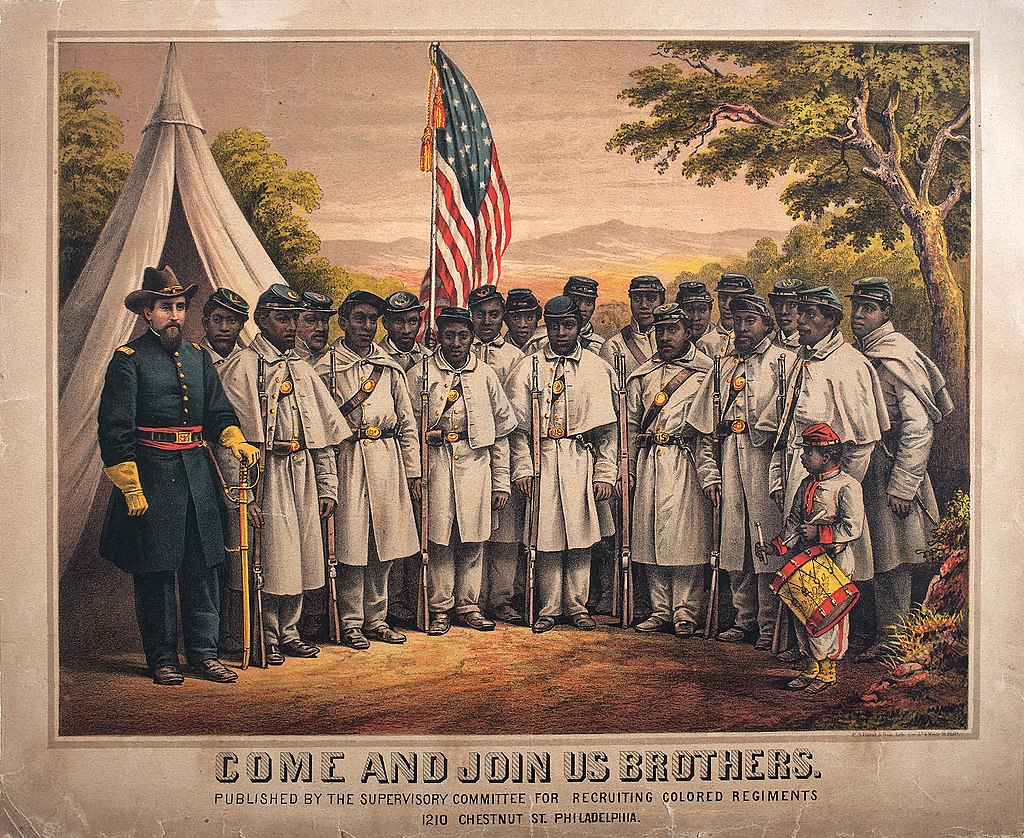“In 1865, President Abraham Lincoln said, “Without the military help of Black American Freedmen, the war against the south could not have been won.”
“As soon as the Civil War began, a war that started to save the union and not to free the enslaved, many free Black Americans in the North wanted to fight for the Union. Though the civil war did not begin to free the enslaved, Black soldiers were fighting for much more than restoring the Union. American Freedmen were fighting to liberate their Negro people that were enslaved in the violent confederate south. Frederick Douglass, who escaped slavery to become a famous abolitionist leader, stated “We are ready and would go.” But prejudice against Black people — both free and slave — was strong and deep in the North as well as the South.”
During the early part of the war, President Lincoln opposed accepting Black American Freedmen into the army. He said that this would push border states like Missouri over to the Confederacy. In effect, both free Black men and escaped slaves were banned from the Union Army.
“My paramount object in this struggle is to save the Union, and is not either to save or to destroy slavery. If I could save the Union without freeing any slave I would do it, and if I could save it by freeing all the slaves I would do it; and if I could save it by freeing some and leaving others alone, I would also do that.”- Abraham Lincoln
In July 1862, Congress passed a law permitting Black men to enlist at a pay rate of $10 per month ($3 less than the pay of a white private). But Congress left it up to the president to determine the duties of Black volunteers.
In 1864, the U.S. Department of the Army ordered all U.S. Colored Troops, composed of Freedmen and recently liberated enslaved people, to be organized into the “XXV Army Corps,” with an estimated 30,000-35,000 soldiers. One of USCT’s noteworthy action was being the first command to occupy Richmond on April 3, 1865.
In May 1865, the entire XXV Corps, led by General Godfrey Weitzel, was transferred to Brownsville, Texas. They were to become the Army of Occupation along the Texas-Mexico border, guarding against Napoleon III’s French troops as well as watching for any resurgent Confederate activity.
According to historical accounts, USCT regiments set sail from Virginia to Mobile, Alabama, and then were to continue on to South Padre Island, Texas. Storms and rough seas on the voyage sapped the infantry of coal and water, forcing the ship to divert to Galveston for supplies. Official records show that several USCT regiments were in Galveston June 18-20, 1865, fortuitous timing that overlapped with Granger’s famous issuing of General Order No. 3.
Thus Granger was joined by his more than 2,000 Union troop regiment and an additional 5,000-10,000 soldiers from the 28th Indiana, 29th Illinois, and combined New York 26th and 31st Regiments of the U.S. Colored Troops that dropped anchor on June 18 in Galveston Bay.
The African American Civil War Memorial commemorates the military service of hundreds of thousands of Civil War era Black soldiers and sailors. Etched into stainless steel panels of the memorial are names identifying 209,145 United States Colored Troops who responded to the Union’s call to arms. In 1865, President Lincoln said, “Without the military help of the Black Freedmen, the war against the south could not have been won.” – https://www.juneteenthlegacyproject.com/united-states-colored-troops
https://en.wikipedia.org/wiki/United_States_Colored_Troops
https://www.doi.gov/blog/defining-moments-and-historic-places-civil-war
https://www.crf-usa.org/black-history-month/black-troops-in-union
https://www.history.com/topics/american-civil-war/american-civil-war-history

George William Commodore served in the U.S. Navy to preserve the nation and abolish slavery during the Civil War. Tintype by unidentified photographer, c. 1865-1867. Collection of National Archives and Records Administration, Washington, D.C. pic.twitter.com/pJtNCXl7WE
— ChristinaProenzaColes (@ProenzaColes) April 18, 2023
